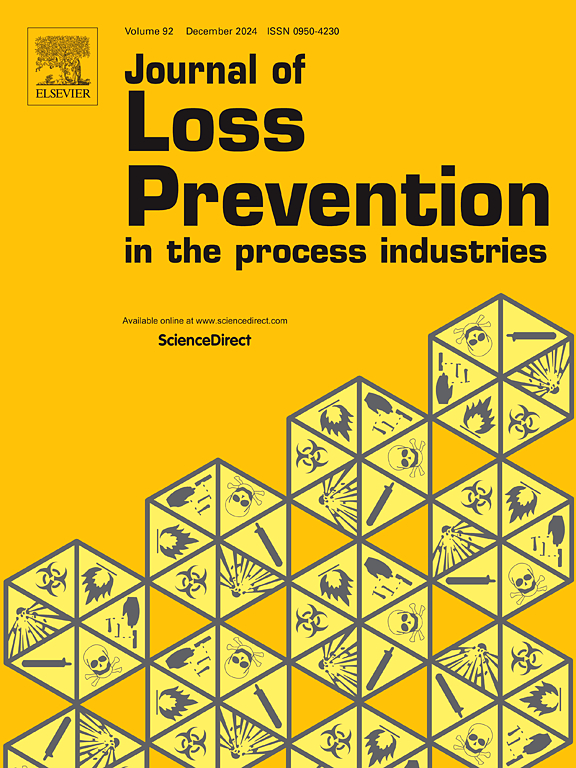Evolution law of selfish psychology in evacuating crowd and its influence on emergency escape
IF 3.6
3区 工程技术
Q2 ENGINEERING, CHEMICAL
Journal of Loss Prevention in The Process Industries
Pub Date : 2025-03-25
DOI:10.1016/j.jlp.2025.105644
引用次数: 0
Abstract
Chemical parks possess unique high-risk attributes and catastrophic characteristics of accident consequences. Beyond the immediate casualties, the non-adaptive psychological behaviors of individuals often lead to more severe casualties. During the evacuation process in chemical accidents, the evolution of the crowd's psychological state, especially the development of selfishness and its impact mechanism on evacuation, still require in-depth research. In this study, AnyLogic was used to develop a system dynamics model of selfish psychological transmission, and parameter values pertaining to environmental attributes, crowd interactions, and group emotional development variables was established. The simulation analyzes the correlation between evacuees' psychological states and critical evacuation parameters, revealing the impact of evolving selfish psychology on the evacuation process under the interaction of various circumstances. The results indicate that when the panic level remains below 0.4, evacuation resources significantly influence the prevalence of pathological selfishness. As the availability of evacuation resources diminishes, a growing proportion of individuals exhibit pathological selfishness, resulting in a substantial increase in group competition rates, which can escalate up to 52.83 %. Moreover, increasing the help probability effectively suppresses the emergence of pathological selfishness and fosters cooperative behavior among pedestrians until 0.8. Notably, enhancing the level of social identity within the group facilitates the transition from pathological selfishness to adaptive selfishness, thereby effectively reducing competition rates. The influence of selfish psychology leads to an inequitable use of exits during evacuation. The crowding and competitive actions of pathologically selfish evacuees at exits can obstruct evacuation. This work elucidates the transmission mechanism of evacuation selfishness and could help disaster management.
疏散人群自私心理的演化规律及其对紧急逃生的影响
化工园区具有独特的高风险属性和事故后果的灾难性特征。除了直接伤亡外,个体的非适应性心理行为往往会导致更严重的伤亡。在化工事故疏散过程中,人群心理状态的演变,特别是自私心理的发展及其对疏散的影响机制仍需深入研究。本研究利用AnyLogic建立了自私心理传递的系统动力学模型,并建立了环境属性、群体互动和群体情感发展变量的参数值。仿真分析了疏散人员心理状态与疏散关键参数的相关性,揭示了在多种情况交互作用下,自私心理的演化对疏散过程的影响。结果表明,当恐慌水平低于0.4时,疏散资源显著影响病理性自私的发生率。随着疏散资源的减少,越来越多的个体表现出病态的自私,导致群体竞争率大幅上升,最高可达52.83%。在0.8之前,帮助概率的增加有效地抑制了病态自私的出现,促进了行人之间的合作行为。值得注意的是,提高群体内部的社会认同水平有助于从病态自私向适应性自私的转变,从而有效地降低竞争率。自私心理的影响导致疏散过程中出口的不公平使用。病态自私疏散者在出口的拥挤和竞争行为会阻碍疏散。本研究阐明了疏散自私的传导机制,有助于灾害管理。
本文章由计算机程序翻译,如有差异,请以英文原文为准。
求助全文
约1分钟内获得全文
求助全文
来源期刊
CiteScore
7.20
自引率
14.30%
发文量
226
审稿时长
52 days
期刊介绍:
The broad scope of the journal is process safety. Process safety is defined as the prevention and mitigation of process-related injuries and damage arising from process incidents involving fire, explosion and toxic release. Such undesired events occur in the process industries during the use, storage, manufacture, handling, and transportation of highly hazardous chemicals.

 求助内容:
求助内容: 应助结果提醒方式:
应助结果提醒方式:


